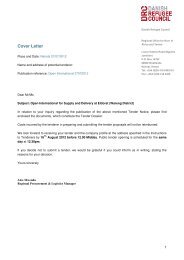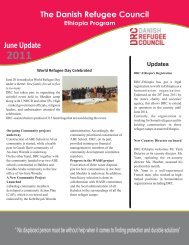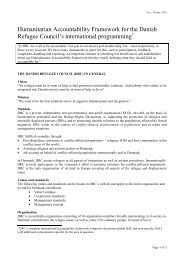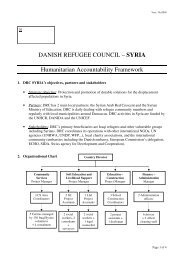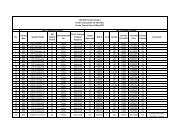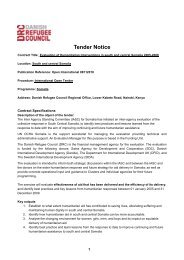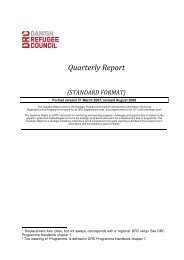Behind the Scenes, Kenya IDP Report - Danish Refugee Council
Behind the Scenes, Kenya IDP Report - Danish Refugee Council
Behind the Scenes, Kenya IDP Report - Danish Refugee Council
Create successful ePaper yourself
Turn your PDF publications into a flip-book with our unique Google optimized e-Paper software.
Chapter 4: The Role of Civil SocietyMilestones in Developing<strong>the</strong> <strong>IDP</strong> Policy:Chapter 5:Navigating through a ToughPolitical Environment• The need for a policy was identified during aworkshop held for national and internationalstakeholders in March and April 2007.• The need to develop a policy was agreedupon during <strong>the</strong> National Stakeholders Forumheld in Nairobi on 30 th and 31 st July2009. MoJNCCA and ASWG were tasked toprovide leadership.• In October 2009, MoJNCCA agreed to spearhead<strong>the</strong> process following a meeting betweenASWG and Prof. Walter Kälin, UN-SRon <strong>IDP</strong>s.• Preparatory work on policy drafting was initiatedbetween August and December 2009.The actual drafting took place between Januaryand February 2010.• Prof. Kälin seconded his legal adviser on <strong>IDP</strong>protection to advise and support <strong>the</strong> draftingin January 2010.• MoSSP took over <strong>the</strong> policy drafting processfrom MoJNCCA following a meeting with<strong>the</strong>ir PS, Prof. Kälin’s advisor and <strong>the</strong> AWSGon 13th January 2010.• The draft policy was submitted to stakeholdersfor validation at a forum hosted by <strong>the</strong>PWGID in Nairobi on 14 th March 2010.• The policy was revised and adopted byMoSSP in April 2010. It was amended in Octoberand December 2010 in line with <strong>the</strong>new Constitution.• PWGID prepared a Cabinet Memo betweenDecember 2010 and February 2011. TheMemo was submitted to <strong>the</strong> Minister ofMoSSP on 16 th March 2011.• Fur<strong>the</strong>r discussions with respect to <strong>the</strong> policywere held with PSC, MoSSP and PWGIDat Pangoni Hotel in Mombasa on 30th September-1 st October 2011; 4-6 December 2011and 29-30 July 2012.• On 18 th July 2012, ASWG, MoSSP and LandsMinistry revised <strong>the</strong> draft policy to complywith <strong>the</strong> Land Act 2011, Land RegistrationAct, 2012 and National Land CommissionAct, 2012.• On 14 th September 2012, MoSSP Ministerconfirmed that <strong>the</strong> Minister of Lands hadsigned <strong>the</strong> <strong>IDP</strong> Policy with a few recommendations.• The Cabinet approved <strong>the</strong> <strong>IDP</strong> Policy on 25 thOctober 2012 and MoSSP is preparing a Sessionalpaper on <strong>the</strong> Policy which will be debatedin Parliament for it to be approved as aNational Policy.Allowing <strong>IDP</strong>s to vote in areas where <strong>the</strong>y have beenresettled will encourage <strong>the</strong> use of options for a durablesolution as a political tool to influence local politicsthrough strategic relocations. If that is <strong>the</strong> position in<strong>the</strong> <strong>IDP</strong> Bill, <strong>the</strong>n I will make sure that <strong>the</strong> bill neversees <strong>the</strong> light of day in <strong>the</strong> house. 75Policymaking closely relates to <strong>the</strong> politics of <strong>the</strong>jurisdiction in which it takes place. This is becausepolicymaking involves building consensus or establishingcooperation among various actors within <strong>the</strong>political field. The interaction between advocacywork and politics contributes to <strong>the</strong> quality of <strong>the</strong> resultingpolicies and determines to a great extent <strong>the</strong>irdurability by ei<strong>the</strong>r hindering or facilitating <strong>the</strong>ir implementation.The <strong>Kenya</strong>n experience in developing<strong>the</strong> <strong>IDP</strong> policy framework provides a rich case studyof how political factors affect policymaking.5.1. Sensitivity of <strong>the</strong> Topic ofInternal Displacement in<strong>Kenya</strong>The recognition of <strong>the</strong> existence of <strong>IDP</strong>s in <strong>Kenya</strong>has generally faced resistance from Government,mainly because of its political and financial implications.<strong>IDP</strong>s are perceived to be a national shameand a reminder of <strong>the</strong> events of <strong>the</strong> 2007/2008post-election violence. Granting official recognitionof an <strong>IDP</strong> status implies providing resettlement,which in turns compounds already existingland problems. Consequently, when engagingwith politicians on <strong>the</strong> subject of internal displacement,undue focus is often placed on whatthis might demand of Government resources andhow it might affect voting patterns if resettlementwere <strong>the</strong> prime solution for resolving <strong>the</strong> situationof <strong>IDP</strong>s.5.1.1. Post-election violence 2007Arguably, <strong>the</strong> violence that erupted after <strong>the</strong> electionsin 2007 marked <strong>the</strong> turning point in effortsto deal with internal displacement. The violencecame to a close after a National Dialogue and ReconciliationProcess that resulted in <strong>the</strong> formationof a coalition government and a comprehensivereform agenda designed to resolve <strong>the</strong> politicalcrisis and its root causes. 76 The comprehensivereform agenda provided a context for calls to <strong>the</strong>Government to respond to internal displacementand provided a basis upon which discussions ona policy framework for <strong>IDP</strong>s began. The PWGIDused this context to call upon <strong>the</strong> President and<strong>the</strong> Prime Minister to establish a comprehensiveframework for <strong>the</strong> protection of <strong>IDP</strong>s, since <strong>the</strong>four agendas developed through <strong>the</strong> reconciliationprocess were to be implemented within a periodof one year from 28 th February 2008. 77 While <strong>the</strong>post-election violence acted as catalyst for advocacywork on <strong>the</strong> protection of <strong>IDP</strong>s, in some instancesit acted as a distorting factor by introducingsubjective standards and concentrating moreon displacement caused by <strong>the</strong> violence in 2007 to<strong>the</strong> exclusion of o<strong>the</strong>r categories of <strong>IDP</strong>s.5.1.2. Ethnic DimensionAlthough <strong>the</strong> Constitution of <strong>Kenya</strong> characterises<strong>the</strong> country as a multi-party democratic state, ethnicaffiliation plays a prominent role in national debates,where actors analyse situations through partisanlenses. Discourses on internal displacement wereassessed through this same lens, with <strong>the</strong> Parliamentaccusing <strong>the</strong> Executive of favouring particularinterest and ethnic groups in its interventions. Thisperception was compounded by <strong>the</strong> failure of <strong>the</strong>22<strong>Behind</strong> <strong>the</strong> <strong>Scenes</strong> – Lessons Learnt from Developing a National Policy Framework on Internal Displacement in <strong>Kenya</strong> 23






